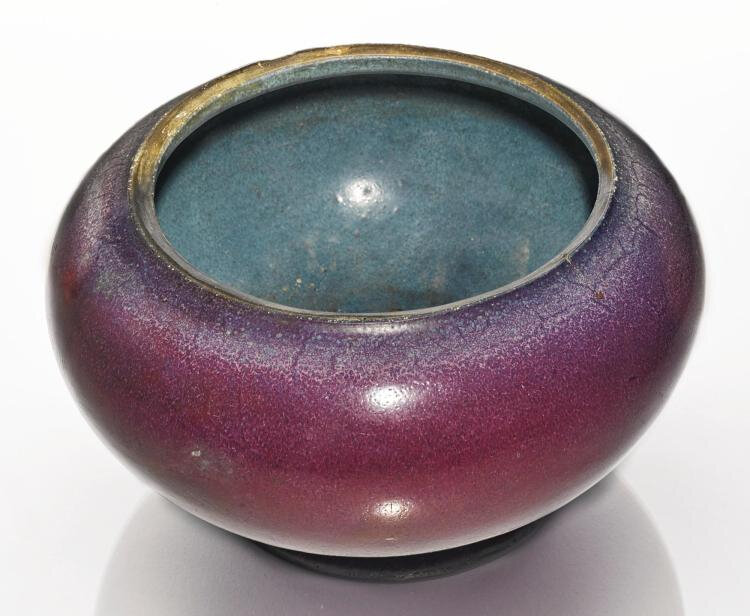A large and rare 'Jun' numbered flower pot, Ming dynasty, 15th century
Lot 2. A large and rare 'Jun' numbered flower pot, Ming dynasty, 15th century. Width 8 1/2 in., 21.6 cm. Estimate 50,000 — 70,000 USD. Photo: Sotheby's.
the well-potted vessel of compressed globular form, rising from a slightly splayed foot, applied with a rich lavender glaze around the rim, draining to a vivid crimson color as it thins over the central curve of the body and pooling to a deep purple around the foot, the interior an intense sky-blue color, the base glazed olive-brown over five pierced drainage holes and incised with the numeral wu (five), with wood stand (2).
Property from the collection of John F. Lewis, Jr
Provenance: Collection of Owen W. Roberts.
Parke-Bernet Galleries, Inc., New York, 4th-5th January 1956, lot 76.
Exhibition: The Metropolitan Museum of Art, New York, 1921.
Note: Numbered 'Jun' wares form a distinct group and are found in seven varying forms, inscribed with a numeral from one to ten, with one indicating the largest size and ten the smallest. Much admired and imitated from the Qing dynasty onwards, these wares continue to elicit appreciation as well as provocation. Traditionally ascribed to the Northern Song dynasty, there has been much debate on the dating of numbered 'Jun' wares, however recent research seems to confirm a 15th century date. As explained in Jessica Harrison-Hall, Ming 50 Years That Changed China, British Museum, London, 2014, pp. 92-97, examples of this numbered group have not been found in any context other than the Beijing palace. None have been discovered elsewhere in China or farther afield, nor have any been excavated from tombs. Additionally the method of construction using double molds did not exist until the early 15th century when it was created by potters at the Henan kilns. The author concludes that they were commissioned by the Yongle and Xuande emperors for the new palace where they were displayed and admired throughout the Ming and Qing dynasties.
Similar examples of 'Jun' numbered flower pots are included in the Illustrated Catalogue of Sung Dynasty Porcelain in the National Palace Museum, Ju Ware, Juan Ware, Chun Ware, Taipei, 1973, pls 51 and 52 (with similarly reduced necks) and pls 47 and 48. Another purple-glazed 'Jun' flower pot from the Qing court collection is illustrated in The Complete Collection of Treasures of the Palace Museum, Porcelain of the Song Dynasty, Hong Kong, 1996, vol. 1, pl. 14. Finally, along with several essays on the topic, a purple-glazed cut-down zhadou, is included in the exhibition catalogue Junyao, Eskenazi, London, 2013, cat. no. 16.
Sotheby's. Monochrome, New York, 15 sept. 2015

/https%3A%2F%2Fprofilepics.canalblog.com%2Fprofilepics%2F1%2F0%2F100183.jpg)
/https%3A%2F%2Fstorage.canalblog.com%2F03%2F02%2F119589%2F96711876_o.jpg)
/https%3A%2F%2Fstorage.canalblog.com%2F11%2F31%2F119589%2F94773502_o.jpg)
/https%3A%2F%2Fstorage.canalblog.com%2F20%2F83%2F119589%2F94772815_o.jpg)
/https%3A%2F%2Fstorage.canalblog.com%2F26%2F72%2F119589%2F75604929_o.jpg)
/https%3A%2F%2Fstorage.canalblog.com%2F59%2F60%2F119589%2F26458628_o.jpg)





/http%3A%2F%2Fstorage.canalblog.com%2F76%2F15%2F119589%2F129393400_o.jpg)
/http%3A%2F%2Fstorage.canalblog.com%2F70%2F68%2F119589%2F129131712_o.jpg)
/http%3A%2F%2Fstorage.canalblog.com%2F13%2F69%2F119589%2F129078661_o.jpg)
/http%3A%2F%2Fstorage.canalblog.com%2F93%2F01%2F119589%2F129030904_o.jpg)